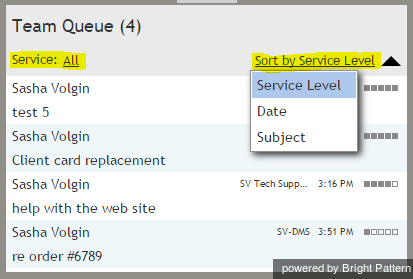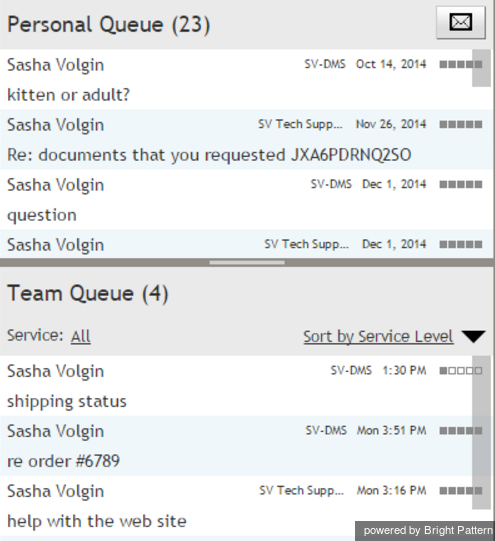Contents
- Introduction
- Starting Your Working Session
- Starting Agent Desktop
- Selecting a Phone Device
- Logging into Agent Desktop
- Installing and Updating the Agent Desktop Helper Application
- User Interface Overview
- Changing Your Agent Desktop Appearance
- Understanding Screen-pop
- Configuring Your User Profile
- Configuring Your Voicemail
- Listening to Voicemail Messages
- Call Forwarding
- Using the Calendar
- Getting Help
- Understanding and Handling Your States
- How to Interpret Your Current State Information
- How to Make Yourself Ready
- How to Make Yourself Not Ready
- Handling Calls
- How to Answer an Incoming Call
- How to Reject an Incoming Call
- How to Make an Internal Call
- How to Make an Outbound Call
- How to Send Numeric Information
- How to Use the Directory
- How to Redial a Previously Dialed Number
- How to Use Favorite Contacts
- How to Mute a Call
- How to Release a Call
- How to Wrap Up After Call Work
- Dispositions and Notes
- How to Hold and Retrieve a Call
- How to Make a Consultation Call
- How to Transfer a Call
- How to Host a Conference
- How to Participate in a Conference
- How to Place a Call in a Service Queue
- How to Connect a Voice Application to Your Call
- How to Use Prerecorded Messages
- How to Record a Call
- How to Stop or Pause Call Recording
- Voice Signatures
- How to Schedule a Follow-up Activity
- How to Send SMS Messages
- Participating in an Outbound Campaign
- General Information About Outbound Campaigns
- How to Review a Calling Record
- How to Reject a Calling Record
- How to Reschedule a Call Attempt
- Handling Service Chats
- How to Accept a Chat Request
- How to Reject a Chat Request
- Chat Messages
- How to Send and Receive Pictures and Documents
- How to Transfer Your Chat Session
- How to Create and Edit Canned Chat Responses
- How to End a Chat Session
- Handling Multiple Chat Sessions
- Handling Mobile Interactions
- Handling Email
- General Information About Handling Email
- Understanding Email Cases and Threads
- How to Accept an Email
- 1 How to Retrieve an Email from the Team Queue
- How to Retrieve an Email from Your Personal Queue
- Overview of the Email Working Area
- How to Review an Incoming Email
- How to Mask Sensitive Data
- How to Close an Email without Replying
- How to Change an Assigned Email Service
- How to Transfer an Email
- How to Forward an Email
- How to Compose a Reply
- How to Send a Follow-up Outbound Email
- How to Send a New Outbound Email
- How to Save an Email as a Draft
- Knowledge Base
- General Information About Knowledge Base
- How to Use a Knowledge Base Article
- Contributing Content to the Knowledge Base
- Other Useful Functions
- Dashboard
- Ways to Request Assistance
- How to Use Internal Chat
- How to Report a Call Quality Problem
- How to Send Agent Desktop Application Logs to Your Administrator
- Ending Your Working Session
- Error Messages
How to Retrieve an Email from the Team Queue
If emails are distributed via the Pull method, they will appear in your team queue. You can immediately see if there are any emails in the queue by checking entry Email in your Active Communications List. The entry will show how many emails you currently have in your personal queue (me) and in the team queue (team).
Viewing Team Queue Content
To view the content of the team queue, select the Email entry. Both your personal and team queues will be displayed in the Contact Info Panel area. You can use the splitters to expand the team queue view.
For each queued email, customer’s display name, arrival date/time, and the subject line will be shown. Depending on your system configuration, an abbreviated service name may also be displayed next to the arrival date/time. If such short names are used, you will receive their descriptions from your system administrator.
To see the full sender’s email address, hover over the customer’s display name.
To see the full service name, hover over the abbreviated service name.
A bar indicator next to each email will indicate how close the current wait time is to breaching the service level agreement (SLA). The SLA is your contact center's "standard" time for replying to customers’ emails. The unshaded portion of the SLA bar represents the time remaining to the SLA breach. This time also defines the default order in which emails appear in the queue. In the following example, the first email is close to breaching the SLA, the second one has about a half of the SLA threshold time remaining, and the third has just arrived.
You can sort emails in the team queue by SLA, arrival date, and subject, and choose either ascending or descending order of email appearance in each case.
Adjusting Team Queue View
If your team is assigned to handling emails for multiple services, you can adjust your team queue view to display emails for any one of those services separately or for all assigned services at once. The name of the currently selected service will be displayed under the queue title. To view another service, click on the currently selected service name and select the desired service from the drop-down menu. To view queued emails for all assigned services, click All.
Note: The limited screen space allocated for the team queue on the screen only allows to see a few emails. You can use scrolling to see more emails.
Preview Email Content Without Retrieving It
You can preview content of an email in the team queue without retrieving it. To preview an email, click it once.
For more information about reviewing email content, see section How to Review an Incoming Email.
Retrieving Email
To retrieve an email for handling, double-click it. The Active Communications List will display the email icon , indicating that you now have an active email on your desktop. For subsequent email handling steps, see section How to Review an Incoming Email.
Note: If subsequent handling of a selected email involves replying or forwarding, you can also retrieve it for handling by selecting the corresponding action from the editing area. For more information, see sections How to Forward an Email and How to Compose a Reply.
Instead of retrieving an email for handling, you can move it to your personal queue for processing at a later time. To move an email to your personal queue, you can either click the Grab button in the reading pane, or drag the selected email from the team queue and drop it anywhere in your personal queue.
You can use the drag-and-drop operation to move multiple emails to your personal queue in one step. Click the desired emails while holding the Ctrl button. (If you select a range, you can click the first and last email in the range while holding the Shift button.) Drag selected emails and drop them anywhere in your personal queue.
Moving Email from Personal Queue to Team Queue
If you have selected an email from the team queue, moved it to your personal queue, and changed your mind, you can move the email back to the team queue. The same drag-and-drop operation is used to move selected emails from your personal queue to the team queue. When moving emails from one queue to another, drafts (if started for the emails) move along with the emails, no questions asked.
Instances in which you may desire to drag emails from your personal queue to the team queue include when an email was
- previously dragged from the team queue to a personal queue for any reason
- transferred from another agent and that agent’s team queue includes the service for which the email was received
- transferred from another agent and that agent’s team queue does not include the service the email for which the email was received. Note that if the service on the message has not changed, it will disappear from your view. Upon dragging the email back to the team queue, you will be offered the selection of email services to which you are assigned.
To move email to the team queue, click the desired emails while holding the Ctrl button. (If you select a range, you can click the first and last email in the range while holding the Shift button.) Drag selected emails and drop them anywhere in the team queue.





